Yesterday morning was my first experience with an Accipiter preying on rodents instead of the small birds that they’re best known for eating.
As one more evidence that I’m more of a bird photographer than I am a birder I’ll admit from the get-go that I’m unsure if this is a Cooper’s Hawk or a Sharp-shinned Hawk. Based on the somewhat rounded shape of the tail-tip and the color of the face my guess would be juvenile Cooper’s but I have no real confidence in that tentative choice. Help!
(note – this bird has now been confirmed by folks whose ID skills I trust, here and on FB, to be a Cooper’s Hawk. Thanks for the help!)
But either way it’s an Accipiter and yesterday morning I watched as it very deliberately perch-hunted voles instead of birds at Farmington Bay. This post is only meant as documentation of that fact – many of the images are mediocre at best.
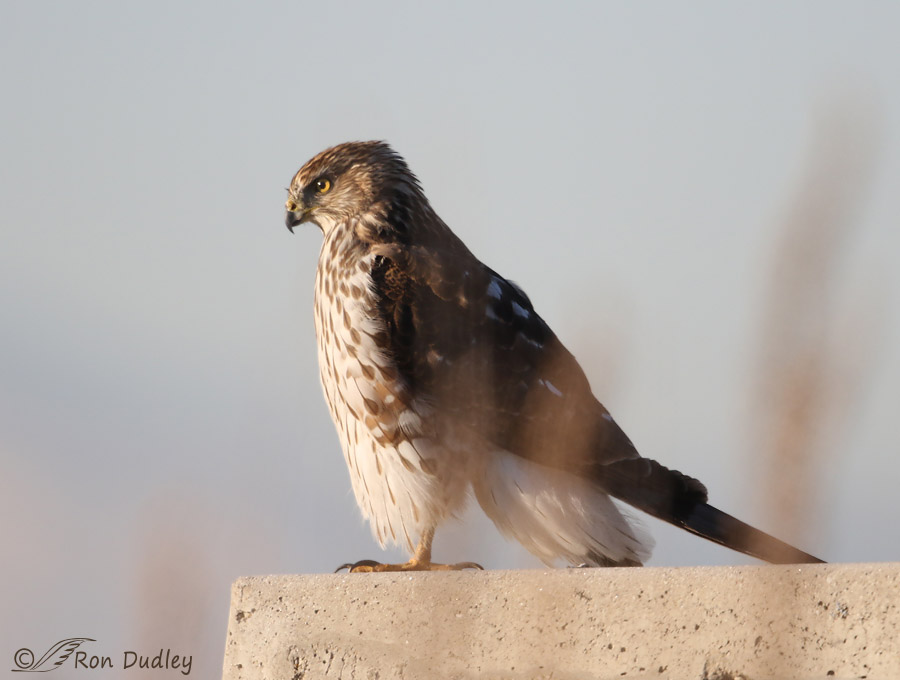
1/2000, f/5.6, ISo 500, Canon 7D Mark 2, Canon EF500mm f/4L IS II USM +1.4 tc, taken and processed in JPEG, not baited, set up or called in
Here the hawk is perch-hunting from a block of concrete overlooking a slope directly in front of it. Moments after this image was taken (through many branches between me and the bird) the hawk pounced on prey only a couple of feet in front of the concrete and disappeared in the vegetation. I assumed that if it had caught prey it would be a small bird and the hawk would fly far off with it.
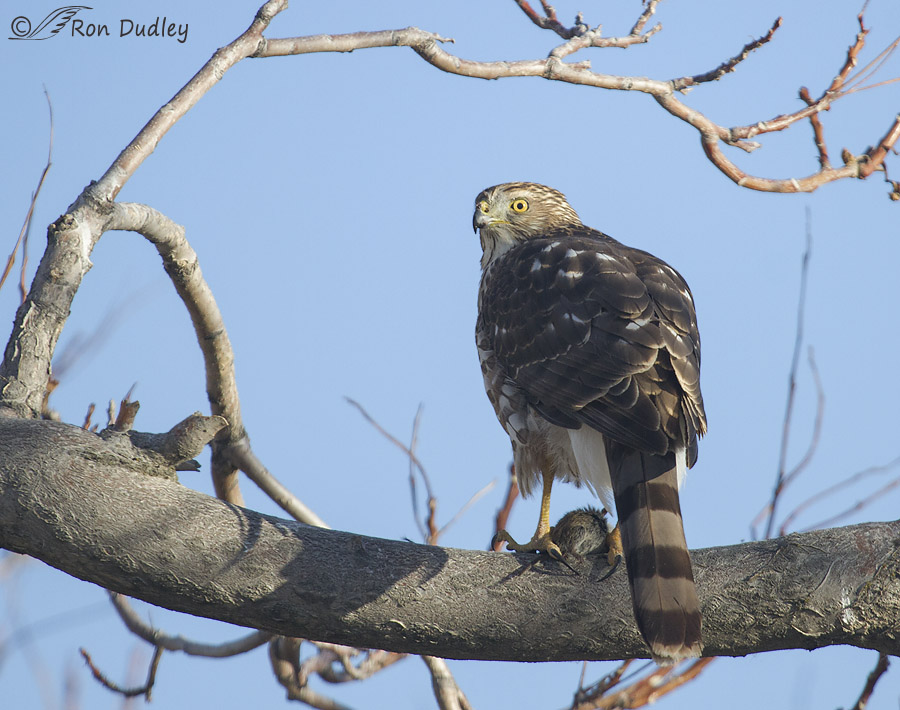
1/1000, f/5.6, ISo 500, Canon 7D, Canon 100-400 @ 400m, not baited, set up or called in
Instead it landed in a nearby tree on the other side of my pick-up. And the prey turned out to be a vole (I don’t believe it was a mouse because I never saw a long tail). I spent the next 17 minutes watching and photographing as the hawk ate the vole and then cleaned up and relaxed after its meal. The bird mostly had its back to me and the setting was cluttered with branches.
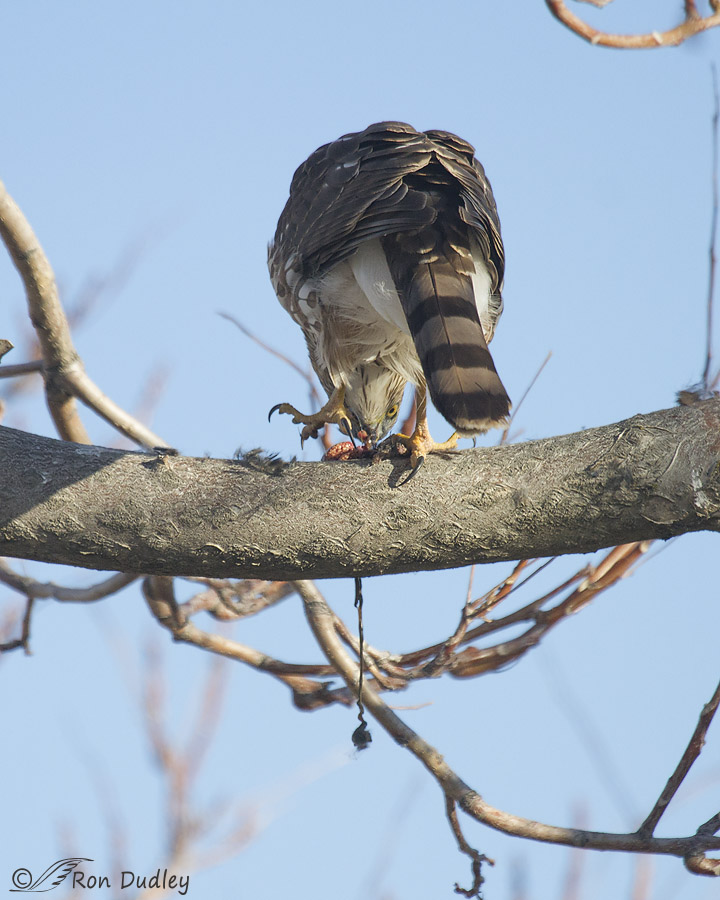
1/1000, f/6.3, ISo 500, Canon 7D, Canon 100-400 @ 400m, not baited, set up or called in
Raptors often reject the intestines of their prey and this bird did just that with some of them but I also saw it gulp down a portion of what appeared to be small intestine. Here you see some of the rejected intestines hanging down from the large horizontal branch.
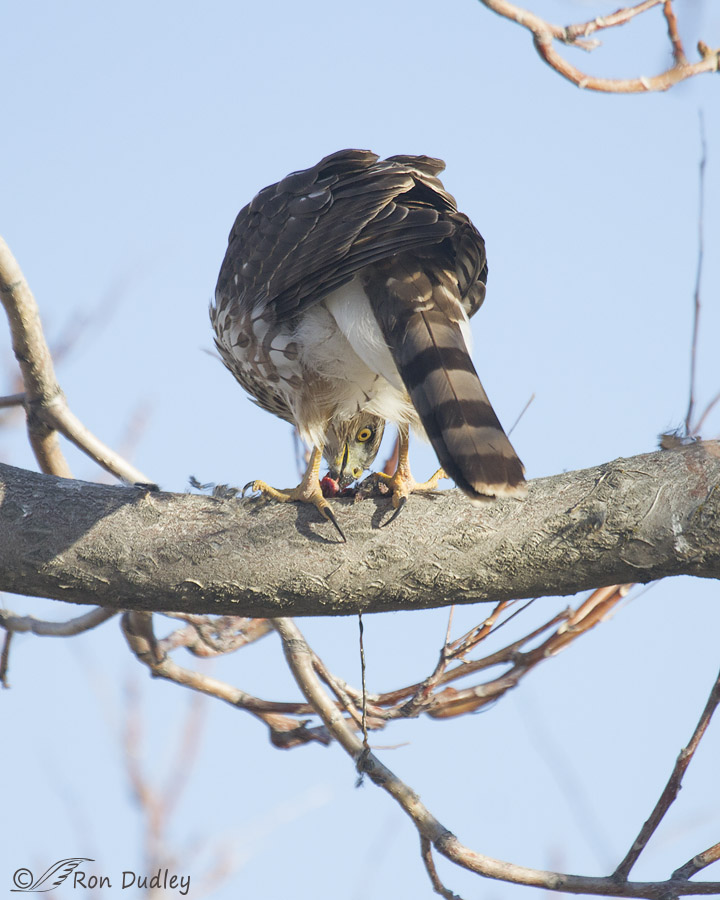
1/1000, f/6.3, ISo 500, Canon 7D, Canon 100-400 @ 400m, not baited, set up or called in
I couldn’t resist including this image with its clear look at the face and eye from the rear and between the legs. It’s a butt-shot for sure but I still enjoy it because it makes me smile…
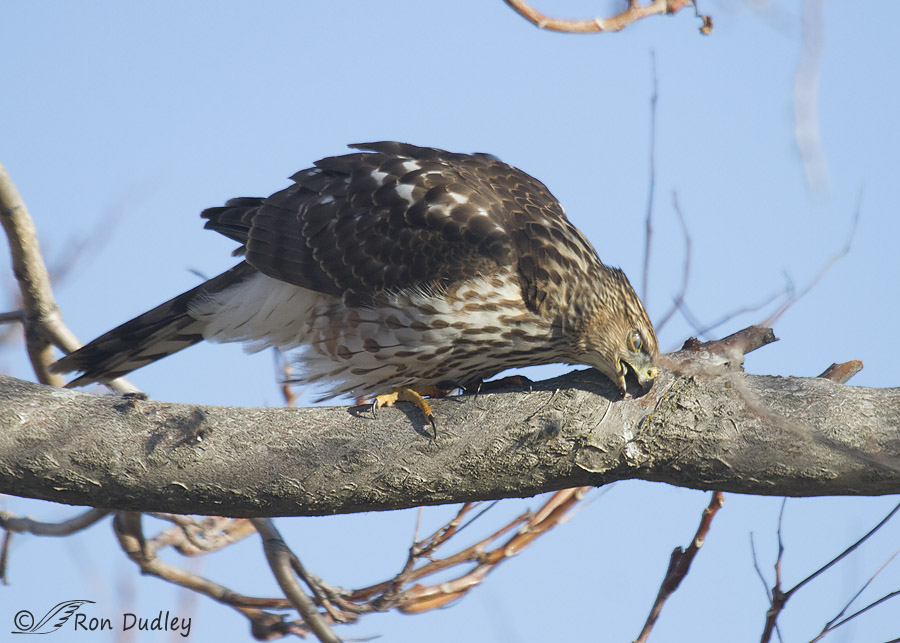
1/1000, f/6.3, ISo 500, Canon 7D, Canon 100-400 @ 400m, not baited, set up or called in
After the vole was consumed the hawk turned toward me on the perch and vigorously cleaned its bill. The nictitating membrane is closed and I like the tongue hanging out during the process.
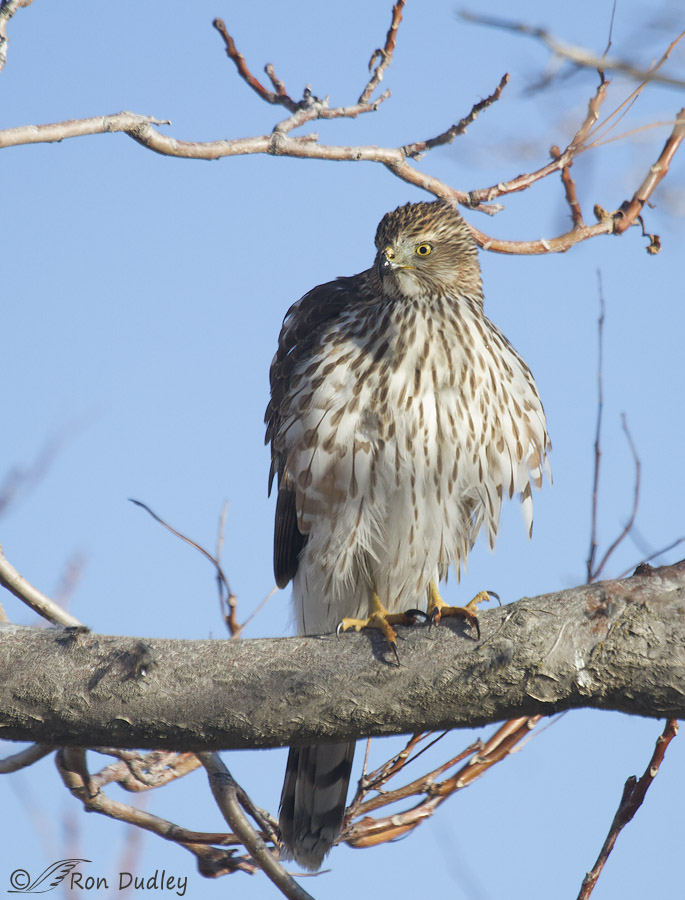
1/1000, f/6.3, ISo 500, Canon 7D, Canon 100-400 @ 400m, not baited, set up or called in
Then the bird gave me a frontal pose in better light.
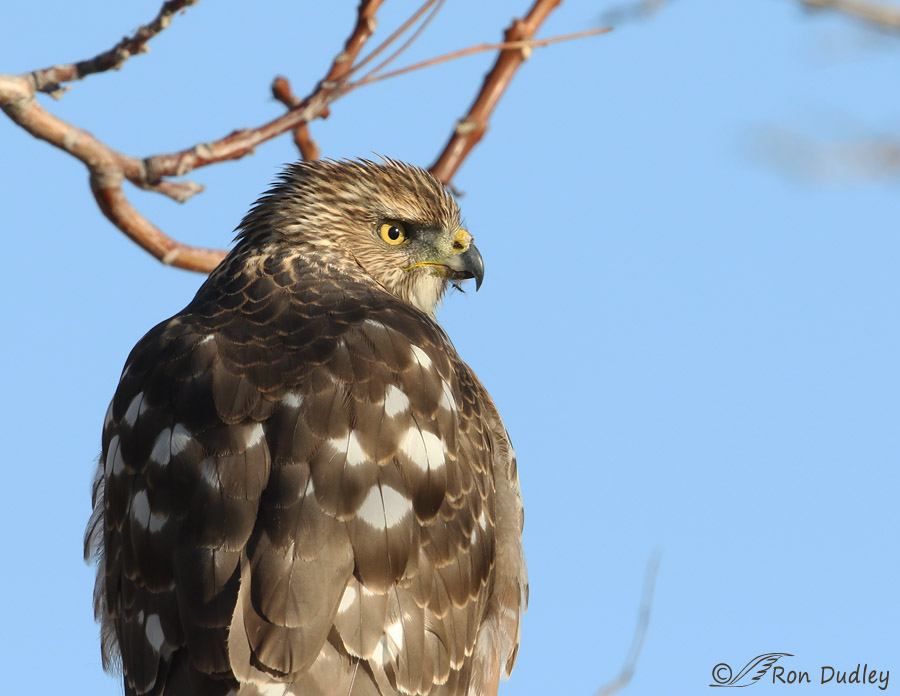
1/320, f/13, ISo 500, Canon 7D Mark 2, Canon EF500mm f/4L IS II USM +1.4 tc, taken and processed in JPEG, not baited, set up or called in
At that point I grabbed my longer lens and took a few head shots before driving on and leaving the bird in the tree.
This hawk was one of the calmest Accipiters I’ve encountered.
Ron
Note to local birders and photographers: Yesterday morning there was an adult Bald Eagle perched on the “eagle tree” at Farmington. This was the first eagle I’ve seen there this season. Another photographer friend saw one that same morning at Bear River MBR. I believe our eagle season is finally beginning!
Note to photographers who have recently purchased the new Canon 7D Mark 2: A few minutes ago I noticed that Adobe has finally updated their DNG converter for ACR (Adobe Camera Raw) and it now supports the Mark 2 (along with the Canon Powershot G7 X and the Canon Powershot SX60 HS). Link here. It’s been a long time coming!


Ron. Our resident coops cleaned out all our chipmunks. We are grateful. They find morning doves easier I think.
Bet yours is a female. Big and beautiful.
Wonderful series Ron! I did see a hawk eat a squirrel in our yard. I suspect it ate it there because it was too heavy to carry it very far.
Charlotte
“Feaking awesome” is right! This really thrills me because, just this morning, a Cooper’s landed on my backyard fountain just outside my bedroom window, and spent several minutes drinking, looking around and (it appeared) relaxing before taking its leave. I’ve had more than one land in a nearby tree after snatching a neighborhood bird, but as soon as they notice me watching, they fly off. So I really appreciate that you got these great shots of a Coop in action.
Thanks, Chris. Isn’t “feaking” an interesting term for the behavior!
I love the butt shot, too. It’s quite a feat to get the face well from the rear. I also really like the shot where the bird is cleaning its bill. Thanks for showing us the behavior – it’s not something we get to see regularly.
Susan, that’s one of those shots where it’s real handy to have the ability to switch to a single focus point. Getting the face sharp through the legs. tail and fluffy feathers in front wasn’t easy.
Isn’t it wonderful that there is ALWAYS something new to see, to learn.
Love the butt shot – and will steal feaking as well.
Continued learning keeps us young, Elephant’s Child. Or at least it keeps us from aging quite so fast. I hope…
As I have come to expect, your posts always teach me something new. Very interesting series of photos documenting this behavior. By the way, I also saw the Bald Eagle yesterday at Farmington Bay and shortly after that I spotted a truck with “HARRIER” plates head my way. Two celebrity sightings within minutes of each other!! It was a great birding day for me.
Yup, that was me, Dennis. Wasn’t it great to see that eagle out there?
Absolutely superb shots – and great behavior and action scenes! Is that a Cooper’s Hawk?
Yes, it is, Carol.
Just a fun set of pictures. I used to live with parrots so I enjoyed seeing the bird stropping its beak. One of my Amazons thought the best place to clean his filthy beak was my hair. Sigh.
“One of my Amazons thought the best place to clean his filthy beak was my hair. Sigh.”
Oh, joy – that and its aftermath sure sounds like fun, Arwen!
Beautiful bird and super good shooting. Curious: do your cameras make sounds when you click? If so, does the noise ever frighten your subjects? BTW, I admire your work and am in awe of your adherence to factual reporting and that you donate your craft daily at no charge.
Bill, The Canon 7D that I’ve been using for 5 years has a relatively loud shutter and sometimes I do see birds react slightly to it. I don’t recall it ever (obviously) frightening a bird away but it may have happened and I didn’t know the actual cause for sure. I nearly always shoot from inside my pickup and I’m sure that muffles the sound significantly. Thankfully, my new camera, the Canon 7D Mark 2, has a much quieter shutter
Hey Ron, I agree about the Coop ID–the relatively fine streaking on the breast is another good mark. It’s always such a neat experience when a bird helps us see it as an individual (the Coop who catches rodents) rather than just an undifferentiated member of a species (“it’s a Cooper’s Hawk”). Makes me wish that I could spend enough time with each bird to learn what is unique about it, individually.
Hi Brian, thanks for the ID confirmation and the reference to the fine streaking on the breast. I’ll make a mental note of that, for sure.
Hope you’re keeping warm down your way!
Beautiful series. Nice images and good behavior documentation. Wonderful!
Thanks very much, Dan.
I witnessed a Cooper’s on a kill in a wooded park that was fenced. He would allow fairly close inspection while mantling his prey. When we got too close he moved off just far enough, but waited for us to leave. When we got back into the car he came back and shortly thereafter flew off with the bird. Maybe the easy source of trees and escape are a reason for their lack of shyness, I don’t know, I have just experienced these guys as being bold. Have had both Cooper’s and Sharp-shinned fly through my property after feeder birds and land a short distance away not concerned about me at all. Now I just have to learn to have my camera at the ready when that happens.
I’ve only had one other experience with a Cooper’s that was less than shy. One attacked a Mourning Dove perched in a tree in my back yard just a few feet above my head and both of them landed in a flurry of feathers almost at my feet. The hawk then flew with the dove to the roof of my house. I happened to have my big lens set up on a tripod nearby and I got this shot just as the dove was “expiring”. It’s the 5th photo down in this link if you’re interested: https://www.featheredphotography.com/blog/2010/09/26/the-frustrations-of-unnatural-perches/
Now, for me, that would be a great photograph! It tells a story, shows the Cooper’s boldness, shows the prey item and gives the viewer a sense of where a Cooper’s can be seen. The fact that it is on your roof and there is an antenna in the background really doesn’t bother me. But, that is me! I like natural situations regardless.
I know you make every effort to be as artistic as possible in a natural environment. That is why I love your shots!!
I would agree with a juvenile (1st year) Cooper’s Hawk.
Great shots of its behavior (“feaking”) and general appearance at different angles.
This fellow looks like he would be bold and fearless, quite typical of the Cooper’s I have run into here in the east! Never have met a Cooper’s that is shy!!
Many thanks for this set.
“Never have met a Cooper’s that is shy!!”
Interesting observation, Dick. This is just about the only one I’ve met that WASN’T shy…
Interesting about the varying levels of boldness. The apparent fearlessness of Cooper’s Hawks drastially reduced their numbers in much of eastern North America a century ago. As the original “chicken hawk” they were hated by farmers, and their legendary boldness made them easy targets; many stories tell of the bird that tackled a chicken in front of the farmer (or his wife), and stayed put while he or she ran into the house, got the gun, and came back out… Looked at from an evolutionary perspective, this represents a new selection pressure that disadvantages such behavior and favors shyness around humans. Nowadays there are far fewer small farmers and a different approach to predator management, focusing on exclusion rather than extirpation, so the selection pressure is considerably lessened (and the hawks have made a remarkable comeback).
Hi Ron, This is a male Cooper’s hawk. We use the females for Falconry more than the males, but I flew a male several years ago and we very impressed with him. As you say, they are more well known for their eating of small birds (often grabbed from backyard bird feeders), but rodents and insects make up about half their total diet.
Most Cooper’s hawks are very nervous and very high strung, but occasionally you find one with a very calm demeanor. I suspect that this bird is one of those exceptions.
FYI- The process of wiping and stropping their beak after eating is called “feaking” by falconers. It is a common practice and important both for hygiene and to keep their beak trim and sharp.
Excellent photos….. as always!
Thanks very much, Mark. It’s just that I’d never seen either species hunt rodents so it seemed slightly unusual to me. I did some research (BNA) and they said that Cooper’s eat “mostly medium-sized birds; some small mammals” but then they go on to say that individuals breeding in the west eat a higher proportion of mammals than those elsewhere.
“Feaking” – that’s a new term for me – many thanks for that. Feaking awesome…!